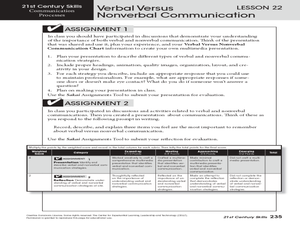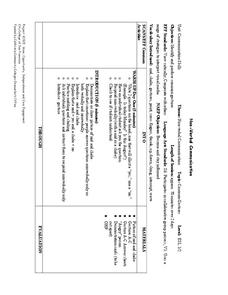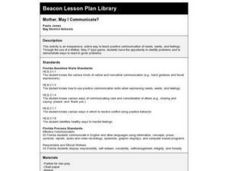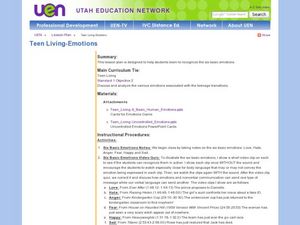Curated OER
Verbal Versus Nonverbal Communication
Young scholars create a multimedia presentation. They will complete a verbal versus non-verbal communication chart to create a multimedia presentation which will include the different types of communication strategies. Then answer a...
University of North Carolina
Communication Studies
A degree in communications incorporates disciplines such as business, law, and media as well. A writing handout offers prospective communications majors information about what kind of assignments to expect in a typical course....
Curated OER
Body Language
Students practice communication skills. In this body language lesson plan, students compare verbal and nonverbal communication as they analyze body language and learn how it conveys emotions.
Curated OER
Non-verbal Cues
Students distinguish between verbal and nonverbal communication. In this communication series activity, students identify the emotions portrayed by photos shown. They role play examples of good and bad listening skills.
Curated OER
Health Education: An Integrated Approach
Fourth graders participate in role plays in order to consider how they use body language and facial expressions to convey their feelings. In this nonverbal communication lesson plan, 4th graders discuss the importance of paying...
Tobii Dynavox
Sono Flex
Empower nonverbal learners with the gift of gab using this speech and language application. Offering hundreds of picture-supported words and phrases, it's easy for students who struggle with verbal communication to have meaningful...
Curated OER
Watch the Road Signs
What makes a good speaker? Upper elementary learners practice oral fluency by working with a partner to read nonfiction books. While reading, they practice using correct tone of voice, making eye contact, and speaking clearly.
Curated OER
Non-Verbal Communication
Students investigate the concept of non-verbal communication and how it is conducted in various social contexts. They use pictures in order to see the kinds of emotion that can be expressed with the posture of the body or looks of the face.
Curated OER
Communication - An Introduction
Students define communication and identify its components. In this communication lesson, students read, discuss, and internalize the four pages of communication elements that include charts, vocabulary, and methods.
Curated OER
Lecture 6 - Oral Interpretation - Verse
Students discuss how oral interpretation varies with prose and poetry. They select a piece of prose or poetry to present to the class, and then assess each other on the organization and delivery of their speech as well as on their...
Curated OER
Character Education: Honesty
Students explore traits of honest communication. In this character development and communication lesson, students are given 6 simple statements and work as a group to alter the meaning of each statement through body language, facial...
Curated OER
The Human Animal
Students explore non-verbal communication. In this animal communication lesson, students study body language and other forms of non-verbal communication. Students write a summary of their findings to discuss with the class. This lesson...
Curated OER
Note-taking and Organizational Strategies
Students practice taking notes. In this written communication lesson, students discuss the purpose of taking notes and then research note-taking methods using the provided Web site tool. Students practice using one of the note-taking...
Curated OER
Exploring a Teaching Career Through an Energy Lesson
After learning how to dentify information on energy and its conservation. your class can work in groups to create an activity and lesson plan for elementary students, teaching all about energy and its conservation. Students demonstrate...
Curated OER
Forensic Colloquium Experience: Debating the Issues
Pupils prepare for an participate in a debate. They watch instructional videos on how debates proceed. Pupils work in teams to research various topics, present their opinions on the issue, and respond to opposing viewpoints during a...
Curated OER
Teaching Each Other Gestures
Students are introduced to the use of gestures in other countries. They define gestures in a personally meaningful way that conveys significance to the entire class. Working in small groups, students play a game to aid them in...
Curated OER
Giving and Receiving Compliments
Students explain why giving sincere compliments is important. In this communication activity, students describe ways to compliment someone either verbal or nonverbal. They discuss their ideas in class.
Curated OER
Mother, May I Communicate?
Students participate in a unique version of the game Mother, May I. They play the game to explore how to positively communicate their needs, wants and feelings, and to demonstrate how to react to problems.
Curated OER
Self-Control Meters for Volume, Space and Levels of Formality
If your pupils have difficulty producing the appropriate voice volume in various settings or respecting personal space, refer to this "control-o-meter" device. This resource includes materials to create three meters for you to...
Curated OER
Writing an Effective Resume
Rating prospective teacher candidates based on sample resumes opens this discussion of effective business communication. After generating a list of interview candidates based on their resumes, pupils justify their choices. A study of...
Read4Health
Piggybook: A Read4Health Lesson Plan
"You are pigs." With those three simple words, the lives of the Piggott family were changed forever. Read aloud the children's story Piggybook by Anthony Browne and teach your class the importance of personal responsibility,...
Curated OER
Teen Living: Six Basic Emotions
Helping teens recognize and identify the six basic emotions, this activity involves a game in which they match feelings with statements on cards. No game card content is attached. View film clips first with no sound to evaluate body...
Curated OER
Coping with Verbs
First graders in a foreign language class explore how verbs function in sentences.
Curated OER
Attractive Adjectives
Third graders, in a foreign language class, identify and use adjectives in sentences.























